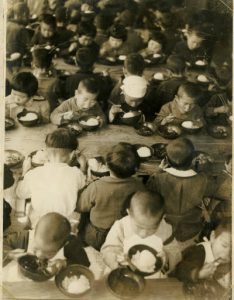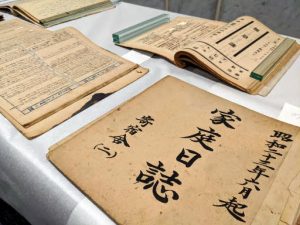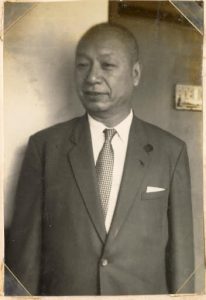Daily records and pictures collected by founder of A-bomb orphans foster home donated to Peace Memorial Museum
Oct. 31, 2019
by Junji Akechi, Staff Writer
On October 30, the Hiroshima Peace Memorial Museum, located in Naka Ward, announced that it had received documents and various other items related to the Hiroshima War Orphans Foster Home, which took in children who had lost their parents to the atomic bomb. These donations were made by the bereaved family of the founder of the foster home, Gishin Yamashita (1894-1989). The total of 465 items consist mostly of daily records and pictures that convey the lives of the A-bomb orphans. A staff member of the museum said,, “Such a large collection of items related to the institutions in Japan caring for the war orphans is unprecedented.”
The daily records were kept, and the photographs taken, between December 1945, when the Hiroshima War Orphans Foster Home was founded based on the principle “Be a father; be a mother,” and January 1953 when the management of the foster home was transferred to the City of Hiroshima. The donations include 210 documents that consist of daily home records in which the staff of the foster home detailed the children’s education and lives, daily cooking records that describe the children’s meals, and fostering records that were collated by Mr. Yamashita in his later years. In addition, there are 214 pictures that show how the children lived.
The daily records also include comments, written in red, that Mr. Yamashita made to staff members at the foster home. The daily dormitory records written in February 1947 show Mr. Yamashita’s encouraging words to a staff member who was anxious that she may not be able to fulfill the role of a surrogate mother. He said, “The most important thing is that we create a place here for the children that they will make memories as if they were with their mothers.” Considering the scarcity of food in those days, Mr. Yamashita wrote in another record, “We don’t have enough staples for ourselves at the moment so we simply can’t serve food to visitors, too.”
Mr. Yamashita was a Buddhist religious figure who was born in the city of Kure and lost his second son to the atomic bomb. When he came to help in war-torn Hiroshima, he became aware of the miserable lives being led by the A-bomb orphans and opened the foster home using his own money. He later served as a member of the Upper House of the Japanese Diet for two terms over a period of 12 years, and he worked hard to establish the Atomic Bomb Medical Relief Law in 1957.
The records and pictures that have been donated were preserved by his eldest son, Akira Yamashita. Mr. Yamashita had handled various requests from researchers, among others, for access to the materials, one by one, but finally decided to donate the items to the Peace Memorial Museum. A museum official said, “These are precious materials that show not only the conditions back then in which the children lived, but also the character of Mr. Yamashita, who paid close attention to the management of the foster home. We will consider how to best make use of these items while also taking into account the privacy of the children who once lived in the foster home.”
Keywords
Hiroshima War Orphans Foster Home
Gishin Yamashita, who later served as a member of the Upper House, opened a foster home in Itsukaichi-cho (now part of Saeki Ward), which was located in a suburb of Hiroshima, in December 1945 with the use of his own money. There, he looked after children who had lost their parents to the atomic bomb. A total of 171 children lived in his foster home until 1953 when its management was transferred to the City of Hiroshima and it become the Hiroshima Municipal War Orphans Foster Home.
(Originally published on October 31, 2019)
On October 30, the Hiroshima Peace Memorial Museum, located in Naka Ward, announced that it had received documents and various other items related to the Hiroshima War Orphans Foster Home, which took in children who had lost their parents to the atomic bomb. These donations were made by the bereaved family of the founder of the foster home, Gishin Yamashita (1894-1989). The total of 465 items consist mostly of daily records and pictures that convey the lives of the A-bomb orphans. A staff member of the museum said,, “Such a large collection of items related to the institutions in Japan caring for the war orphans is unprecedented.”
The daily records were kept, and the photographs taken, between December 1945, when the Hiroshima War Orphans Foster Home was founded based on the principle “Be a father; be a mother,” and January 1953 when the management of the foster home was transferred to the City of Hiroshima. The donations include 210 documents that consist of daily home records in which the staff of the foster home detailed the children’s education and lives, daily cooking records that describe the children’s meals, and fostering records that were collated by Mr. Yamashita in his later years. In addition, there are 214 pictures that show how the children lived.
The daily records also include comments, written in red, that Mr. Yamashita made to staff members at the foster home. The daily dormitory records written in February 1947 show Mr. Yamashita’s encouraging words to a staff member who was anxious that she may not be able to fulfill the role of a surrogate mother. He said, “The most important thing is that we create a place here for the children that they will make memories as if they were with their mothers.” Considering the scarcity of food in those days, Mr. Yamashita wrote in another record, “We don’t have enough staples for ourselves at the moment so we simply can’t serve food to visitors, too.”
Mr. Yamashita was a Buddhist religious figure who was born in the city of Kure and lost his second son to the atomic bomb. When he came to help in war-torn Hiroshima, he became aware of the miserable lives being led by the A-bomb orphans and opened the foster home using his own money. He later served as a member of the Upper House of the Japanese Diet for two terms over a period of 12 years, and he worked hard to establish the Atomic Bomb Medical Relief Law in 1957.
The records and pictures that have been donated were preserved by his eldest son, Akira Yamashita. Mr. Yamashita had handled various requests from researchers, among others, for access to the materials, one by one, but finally decided to donate the items to the Peace Memorial Museum. A museum official said, “These are precious materials that show not only the conditions back then in which the children lived, but also the character of Mr. Yamashita, who paid close attention to the management of the foster home. We will consider how to best make use of these items while also taking into account the privacy of the children who once lived in the foster home.”
Keywords
Hiroshima War Orphans Foster Home
Gishin Yamashita, who later served as a member of the Upper House, opened a foster home in Itsukaichi-cho (now part of Saeki Ward), which was located in a suburb of Hiroshima, in December 1945 with the use of his own money. There, he looked after children who had lost their parents to the atomic bomb. A total of 171 children lived in his foster home until 1953 when its management was transferred to the City of Hiroshima and it become the Hiroshima Municipal War Orphans Foster Home.
(Originally published on October 31, 2019)










